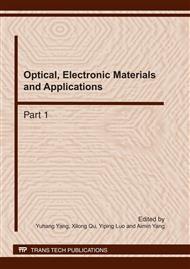[1]
E Tzimas, A Zavaliangos: A comparative characterization of near-equiaxed microstructures as produced byspray casting.Materials Science and Engineering, Vol. 289 (2000), pp.217-227.
DOI: 10.1016/s0921-5093(00)00907-2
Google Scholar
[2]
Manoharan M, Gupta M, Lai M O: Application of model for work hardening behavior of SiC reinforced magnesium based metal matrix composites. Materials Science and Technology, Vol. 16(2000), pp.670-674.
DOI: 10.1179/026708300101508252
Google Scholar
[3]
W. Zhou, Z. M. Xu: Casting of SiC Reinforced Metal Matrix Composites. Journal of Materials Processing Technology, Vol. 63(1997): 358-363.
DOI: 10.1016/s0924-0136(96)02647-7
Google Scholar
[4]
S. Jayalakshmi, S.V. Kailas, S. Seshan. Tensile behaviour of squeeze cast AM100 magnesium alloy and its SiC fibre reinforced composites. Composites, Part A 33 (2002) , p.1135–1140.
DOI: 10.1016/s1359-835x(02)00049-0
Google Scholar
[5]
M.C. Gui, J, M. Han , P.Y. Li: Microstructure and mechanical properties of Mg–Al9Zn/SiCp composite produced by vacuum stir casting process. Materials Science and Technology, Vol. 20 (2004), pp.765-771.
DOI: 10.1179/026708304225017319
Google Scholar
[6]
Hu L X, Wang E D: Fabrication and mechanical properties of SiCw ZK51A magnesium matrix composites by two-step squeeze casting. Materials Science and Engineering, Vol. 27 (2000), P. 267-271.
DOI: 10.1016/s0921-5093(99)00608-5
Google Scholar
[7]
D.H. Baea , M.H. Lee, K.T. et al. A pplication of quasicrystalline particles as a strengthening phase in Mg–Zn–Y alloys. Journal of Alloys and Compounds, Vol. 342 (2002) , p.445–450.
DOI: 10.1016/s0925-8388(02)00273-6
Google Scholar
[8]
V. Sklenicka , M. Svoboda , M. Pahutova, et al. Microstructural processes in creep of an AZ91 magnesium-based composite and its matrix alloy. Materials Science and Engineering, Vol. A319–321 (2001) , p.741–745.
DOI: 10.1016/s0921-5093(01)01023-1
Google Scholar
[9]
Wei Haikun: Theory and Method of Neural Network Structure, Beijing: Defense Industry Press, (2005).
Google Scholar
[10]
Gu xiao-qing, Yi dang-xiang, Liu chun-he: Optimization of Topological Structure and Weight Value of Artificial Neural Network Using Genetic Algorithm. Journal of Guangdong University of Technology, Vol. 23(2006), pp.64-69.
Google Scholar
[11]
YAN Tai-shan. Research on neural network training algorithm based on genetic algorithm. Journal of Hunan Institute of Science and Technology (Natural Science), Vol. 20 (2007),: p.31–34.
Google Scholar
[12]
Dong Zhibo, Wei yan-hong, Zhan xiao-hong etc.: Optimization of mechanical properties prediction models of welded joints combined neural network with genetic algorithm. Transactions of the China Welding Institution, Vol. 28(2007), pp.69-72.
Google Scholar
[13]
Fecit research center: NN theory and its realization in MATLAB7. 0, publishing house of electronics industry, Beijing, (2005).
Google Scholar


